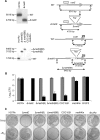A riboswitch regulates expression of the coenzyme B12-independent methionine synthase in Mycobacterium tuberculosis: implications for differential methionine synthase function in strains H37Rv and CDC1551
- PMID: 17307844
- PMCID: PMC1855906
- DOI: 10.1128/JB.00040-07
A riboswitch regulates expression of the coenzyme B12-independent methionine synthase in Mycobacterium tuberculosis: implications for differential methionine synthase function in strains H37Rv and CDC1551
Abstract
We observed vitamin B(12)-mediated growth inhibition of Mycobacterium tuberculosis strain CDC1551. The B(12) sensitivity was mapped to a polymorphism in metH, encoding a coenzyme B(12)-dependent methionine synthase. Vitamin B(12)-resistant suppressor mutants of CDC1551 containing mutations in a B(12) riboswitch upstream of the metE gene, which encodes a B(12)-independent methionine synthase, were isolated. Expression analysis confirmed that the B(12) riboswitch is a transcriptional regulator of metE in M. tuberculosis.
Figures




References
-
- Blount, K. F., and R. R. Breaker. 2006. Riboswitches as antibacterial drug targets. Nat. Biotechnol. 24:1558-1564. - PubMed
-
- Blount, K. F., J. X. Wang, J. Lim, N. Sudarsan, and R. R. Breaker. 2006. Antibacterial lysine analogs that target lysine riboswitches. Nat. Chem. Biol. 3:44-49. - PubMed
-
- Cole, S. T., R. Brosch, J. Parkhill, T. Garnier, C. Churcher, D. Harris, S. V. Gordon, K. Eiglmeier, S. Gas, C. E. Barry III, F. Tekaia, K. Badcock, D. Basham, D. Brown, T. Chillingworth, R. Connor, R. Davies, K. Devlin, T. Feltwell, S. Gentles, N. Hamlin, S. Holroyd, T. Hornsby, K. Jagels, A. Krogh, J. McLean, S. Moule, L. Murphy, K. Oliver, J. Osborne, M. A. Quail, M. A. Rajandream, J. Rogers, S. Rutter, K. Seeger, J. Skelton, R. Squares, S. Squares, J. E. Sulston, J. Taylor, S. Whitehead, and B. G. Barrell. 1998. Deciphering the biology of Mycobacterium tuberculosis from the complete genome sequence. Nature 393:537-544. - PubMed
Publication types
MeSH terms
Substances
LinkOut - more resources
Full Text Sources
Molecular Biology Databases

